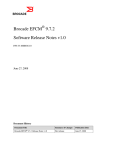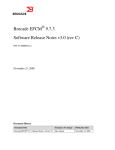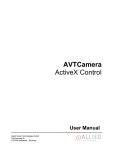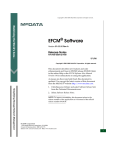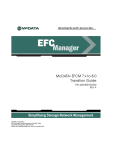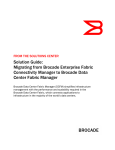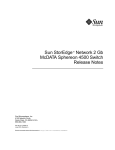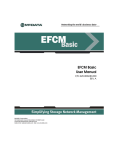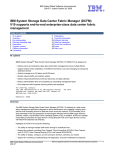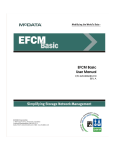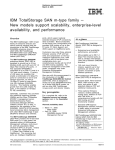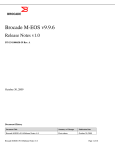Download Brocade EFCM 9.7.4 Software Release Notes v2.0 (Rev B)
Transcript
® Brocade EFCM 9.7.4 Software Release Notes v2.0 (Rev B) P/N 53-1000636-13 August 25, 2009 Document History Document Title Summary of Changes Publication Date Brocade EFCM 9.7.4 Release Notes v1.0 (Rev A) First release April 17, 2009 Brocade EFCM® 9.7.4 Release Notes v2.0 (Rev B) Second release – Added update for the EFC Manager Software User manual for In Band Management. August 25, 2009 ® Copyright © 2006-2009 Brocade Communications Systems, Inc. All Rights Reserved. Brocade, Fabric OS, File Lifecycle Manager, MyView, and StorageX are registered trademarks and the Brocade Bwing symbol, DCX, and SAN Health are trademarks of Brocade Communications Systems, Inc., in the United States and/or in other countries. All other brands, products, or service names are or may be trademarks or service marks of, and are used to identify, products or services of their respective owners. Notice: This document is for informational purposes only and does not set forth any warranty, expressed or implied, concerning any equipment, equipment feature, or service offered or to be offered by Brocade. Brocade reserves the right to make changes to this document at any time, without notice, and assumes no responsibility for its use. This informational document describes features that may not be currently available. Contact a Brocade sales office for information on feature and product availability. Export of technical data contained in this document may require an export license from the United States government. The authors and Brocade Communications Systems, Inc. shall have no liability or responsibility to any person or entity with respect to any loss, cost, liability, or damages arising from the information contained in this book or the computer programs that accompany it. The product described by this document may contain “open source” software covered by the GNU General Public License or other open source license agreements. To find-out which source software is included in Brocade products, view the licensing terms applicable to the open source software. And obtain a copy of the programming source code. Please visit http://www.brocade.com/support/oscd. EFCM® Software v9.7.4 Page 2 of 23 Contents Overview .......................................................................................................................................................................4 What’s New in EFCM Version 9.7 ................................................................................................................................5 New Hardware Support .............................................................................................................................................5 New Features .............................................................................................................................................................5 Upgrade/Downgrade Considerations .............................................................................................................................5 Operating Systems Supported........................................................................................................................................5 Server / Client ............................................................................................................................................................6 Product Operating Notes ...............................................................................................................................................7 Flavors .......................................................................................................................................................................7 Compatibility .............................................................................................................................................................7 Configuring the Number of Event Limits ..................................................................................................................8 Disabling the SNMP Proxy .......................................................................................................................................9 Managing Blade Switch Considerations ....................................................................................................................9 Important Notes ........................................................................................................................................................... 10 Zoning Related Change for FOS-based Fabrics ...................................................................................................... 10 Issue ..................................................................................................................................................................... 10 Solution................................................................................................................................................................ 10 Fabric Binding ......................................................................................................................................................... 11 Fabric Binding In B model Routing Environments ............................................................................................. 13 Advanced Call Home ........................................................................................................................................... 14 No Disk Error upon Launching Local Client ....................................................................................................... 14 EFC Manager Software User Manual (53-1000663-03).............................................................................................. 20 Related Documentation ............................................................................................................................................... 20 Opening the Online Help ......................................................................................................................................... 21 Opening the User Manuals ...................................................................................................................................... 21 Closed With Code Change Defects for EFCM 9.7.4 ................................................................................................... 22 EFCM® Software v9.7.4 Page 3 of 23 Overview Brocade Communications Systems, Inc. is pleased to deliver the EFCM® 9.7.4 release. • A list of the defects that were closed in EFCM® 9.7.4 has been added to the end of these release notes. Refer to the EFCM 9.7 software manual set and online help for instructions on using this application. As issues are discovered and fixed, this document is updated. The most recent version of documentation is provided on the Brocade Web site, through Brocade Connect. Go to http://www.brocade.com and click Brocade Connect to register at no cost for a user ID and password. Note: To improve readability, this document refers to the release number of the application as 9.7.4 instead of the official release number 09.07.04. Note: For your convenience, we have retained the legacy McDATA names to avoid any confusion. Please refer to the following table for the equivalent Brocade names for legacy McDATA products. Brocade Names Legacy McDATA Names Brocade EFCM EFCM Brocade M-EOSc E/OSc Brocade M-EOSn E/OSn Brocade M6140 Director Intrepid 6140 (ED-6140) Brocade M4700F Switch Sphereon 4700 Brocade Mi10k Director Intrepid 10000 Director (i10k) EFCM® Software v9.7.4 Page 4 of 23 What’s New in EFCM Version 9.7 The focus of the EFCM 9.7 release is to cover the 8Gb switches. This includes Native Interoperability support for these platforms as well into M-EOS environments. Support for 8Gb HBAs is also included with this release. Other specific enhancements are outlined in detail below. New Hardware Support 8Gb switches: • Brocade 5300 • Brocade 5100 • Brocade 300 8Gb HBAs • Brocade 415 • Brocade 425 • Brocade 815 • Brocade 825 New Features • Native Interoperability support for the 8Gb switches • Access Gateway support for the Brocade 300 switch • Cascaded FICON support between Mi10k/M6140 and Brocade 48000/Brocade DCX: configuration of and management of cascaded FICON will be accomplished via a combination of EFCM and the FOS element managers (Web Tools) • IPv6 support for the Mi10k and M6140 from the EFCM client to the server to the switch • Fabric Binding support for Open Fabric mode (InterOp Mode 3). o Note: Please refer important notes section for Fabric Binding support in B model Routing Environments Upgrade/Downgrade Considerations • If you have EFCM 8.7 or later, you can perform a direct migration to EFCM 9.7.4 without a stop-over at EFCM 9.1. • If you have SANavigator 4.2 and 4.2.1, first upgrade to EFCM 9.5 or 9.6 and then to EFCM 9.7.4 • Upgrade your EFCM/CM to EFCM 9.7.x/CM 9.7.x before upgrading the Mi10k director to M- EOSn 9.7 or later • If you have HAFM 8.8 or later, first upgrade to EFCM 9.5 or 9.6 and then to EFCM 9.7.4 For detailed upgrade instructions, refer to the EFCM Software Upgrade Instructions provided in the EFCM 9.7 documentation CD-ROM. Operating Systems Supported EFCM 9.7.4 is supported on the following operating systems. EFCM® Software v9.7.4 Page 5 of 23 Server / Client Operating System Versions Windows XP Professional SP2 2003 Server SP2 2000 Professional SP41 Solaris 9, 10 Linux Red Hat 9.0, kernel 2.4.20, Red Hat ES version 3, kernel 2.4.21 Red Hat ES version 4, kernel 2.6.9-5 SuSe Linux Professional Edition 9.2, kernel 2.6.x SuSe Linux Professional Edition 9.3, kernel 2.6.x 1 No support for IPv6 on Windows 2000. EFCM® Software v9.7.4 Page 6 of 23 Product Operating Notes Flavors The flavors supported in the EFCM 9.7.4 release are: • Connectrix Manager • EFCM Compatibility The following table describes the firmware that EFCM 9.7.4 supports for both B model and M model switches and directors. Operating System Switch/Director Switch Type (B-Model) Firmware Versions FOS 5.2.x, 5.3.x, 6.0.x, 6.1.0, 6.1.1, 6.1.2 and 6.2 Brocade 7500 Brocade 200E Brocade 5000 Brocade 4900 Brocade 48000 with FC4-16, FC4-32 and FC4-48 blades Brocade 48000 with FC8-162, FC8-323 and FC8-483 blades Brocade DCX with FC8-162, FC8-322 and FC8-48 blades2 Brocade DCX with FR4-18i blades2 Brocade DCX with FC10-6 blades2 Brocade 3003 Brocade 51003 Brocade 53003 ____________________________ 2 Requires FOS 6.0.0 or higher 3 Requires FOS 6.1.0 or higher EFCM® Software v9.7.4 Page 7 of 23 Blade Type (B-Model) Firmware Versions FOS 5.2.x, 5.3.x, 6.0.x, 6.1.0, 6.1.1, 6.1.2 and 6.2 Brocade 3014 Brocade 3016 Brocade 4020 Brocade 4016 Brocade 4024 Brocade 4018 Brocade 4012 Brocade 54103 Switch Type (M-Model) Firmware Versions M-EOSc 9.1, 9.2, 9.6, 9.6.1, 9.6.2, 9.7, 9.7.1, 9.7.2, 9.8, 9.8.1 9.9 and 9.9.2 Brocade M6064 and M6140 Brocade M4300, M4400, M4500 and M4700 Brocade M3016, M3032, M3216 and M3232 E/OSi 4.7 and 5.0 Brocade M1620 and M2640 M-EOSn 6.x, 9.1, 9.2, 9.6, 9.6.1, 9.6.2, 9.7, 9.7.1, 9.7.2, 9.8, 9.8.1, 9.9 and 9.9.2 Brocade Mi10k M-EOSc 9.0, 9.1, 9.2, 9.6, 9.6.2, 9.7, 9.7.1 9.7.2 , 9.8, 9.8.1, 9.9 and 9.9.2 QPM (Quad Port Module) card for Brocade M6064 and M6140 and LMQ 4G line module for the Brocade Mi10k director M-EOSn 9.1, 9.2, 9.6, 9.6.1, 9.6.2, 9.7, 9.7.1 9.7.2, 9.8 ,9.8.1, 9.9, 9.9.1 and 9.9.2 E/OSq 5.2.2, 5.2.3, 5.5.1, 5.5.2 and 6.4.0. M model blade switch Configuring the Number of Event Limits Perform the following steps to control how many event entries are read in from the event logs on the server, when the Client Monitor->Logs dialogs are used to review specific log categories, such as Audit logs. By default, only the last 2000 entries are scanned (default smp.logs.limit value) for events matching the dialog category (e.g. Audit) to display. 1. On the EFCM client navigate to the following directory location: <EFCM Installation Home>\resources\Client. EFCM® Software v9.7.4 Page 8 of 23 2. Open the config.properties file in a text editor. For example, use a text editor like Microsoft Window's Notepad. 3. Modify the smp.logs.limit parameter to the desired value. The values should be an integer in the range, 2000 to 20000. Any value other than this range or non-integer values like alphanumeric characters would result in the EFCM client failing to start. 4. After specifying valid values for this parameter, start the EFCM client application. Note a: Whenever you change the value of this parameter, you need to restart the EFCM client for the latest value to take effect. Note b: The Monitor Logs dialogs will still display a maximum of 1000 entries that match the item category. This display limit is not configurable. Note c: The smp.logs.limit parameter does not alter the behavior of the Master Log display, which is limited by design to displaying entries from the most recent 2000 logged events on the EFCM server. This limit is not configurable. Use the Monitor Logs dialogs to review older entries or review the Event log files on the EFCM Server host directly. Disabling the SNMP Proxy SNMP Proxy is enabled by default on all M model Blade switches. To ensure proper function of EFCM, disable the SNMP Proxy feature before attempting to discover the M model Blade switch in EFCM. Perform the following steps to disable the SNMP Proxy: 1. Telnet to the switch. 2. Login to the switch. 3. Type admin start and press ENTER. 4. Type set setup snmp and press ENTER. 5. Set the Proxy Enable setting to False. 6. At Do you want to save and activate the snmp setup? (y/n): [n] type y (yes). Managing Blade Switch Considerations If an error message, “received error in attempt to release admin privileges - reason: no response” is received while configuring the secure socket shell (SSH) service for switch blades using Element Manager, you must install the M model Element Manager feature. Do not use the Element Manager fabric binding feature on blade switches. Element Manager fabric binding does not synchronize with EFCM fabric binding. Therefore, if you use both the Element Manager and EFCM fabric binding features you can create a disconnect between the two features and this may result in any of the following: • If you activate an ISL set when a port set is already active, the ISL set takes over and vise-versa (working as designed). • If you activate switch binding within Element Manager and then activate fabric binding within EFCM, the fabric binding is stored by the blade and appended to the current switch binding security policy (working as designed). • However, after carrying out the above procedure, if you deactivate fabric binding within EFCM it only deactivates on the M model switches. To deactivate the policy on the Element Manager, you must open the Element Manager and deactivate the policy there. EFCM® Software v9.7.4 Page 9 of 23 • Note that switch binding is deactivated when the learned fabric policy is merged. To activate switch binding, you must activate the policy you created within the Element Manager again manually. Failure to perform this task can lead to a security lapse. • If switch binding is not activated within an Element Manager and fabric binding is activated within EFCM, deactivate fabric binding on the switch using EFCM (working as designed). • If switch binding is activated through an Element Manager and there is a F_Port logged into the blade that is not in the switch binding membership list (for example, an administrator command has not logged out the unwanted port), then fabric binding cannot be activated using EFCM. Important Notes EFCM 9.7.4 does not support discovery and management of Virtual Fabric feature enabled B-Model switches. Traffic Isolation and Frame Redirect Zone: Customers must upgrade to EFCM 9.7.4 if the fabric Contains Traffic Isolation (TI) or Frame Redirect (RD) zones. EFCM 9.7.4 will not support creating/deleting or updating Traffic Isolation or Frame Redirect zones. However if the fabric has Traffic Isolation or Frame Redirect zones, EFCM will not modify or clear them upon activation of other zone sets EFCM will fail to collect zone information if the B-model switch prompts to change its default password. Zoning dialog will fail to show active zones in the active zone set tab and the activate button will be disabled when the switch prompts to change its default password. To overcome this condition, user needs to configure the new passwords via web tools / telnet. Zoning Related Change for FOS-based Fabrics Issue Previous versions of EFCM prefix the zoneset name and zone name with "SMP_" upon activation of a zoning configuration for Brocade FOS-based fabrics. This was designed to prevent the deletion of zones and zone sets created and activated outside of EFCM. Retaining this design will introduce issues with LSAN and any other zoning prefixes used by FOS to do specific tasks. Solution Customers upgrading from versions prior to EFCM 9.6 to EFCM 9.7.4 will see the "SMP_" prefix in the Zoning dialog box for Brocade FOS-based fabrics. EFCM Brocade Plug will not prefix the zone set/zone name when it does the zone set activation on B model switches. Hence, when zone set activation is done through EFCM on B model switches, it will not prefix with "SMP_" for the zone set/zone name. The following options can be used to resolve this issue, but are only applicable to Brocade FOS-based fabrics that were zoned using a previous version of EFCM. Option 1: Use Export/ Import 1. Install EFCM 9.7.4 and migrate. EFCM® Software v9.7.4 Page 10 of 23 2. Save the active zone set of the Brocade FOS-based fabric into the Zoning Library. 3. Export the active zone set. 4. Edit the exported xml file and remove the "SMP_" prefix from all zones and zone sets. 5. Save the zone set xml file. 6. Import the xml file. The library should not show the zones or zonesets with the "SMP_" prefix. 7. Activate the imported zone set. 8. Using CLI, verify that the active zone set does not contain any zones or zone sets having the "SMP_" prefix. Option 2: Copy Active Zone Set into Library and Migrate 1. Before migrating to EFCM 9.7.4 : • Save the active zone set of the Brocade FOS-based fabric into the Zoning Library. • Shut down the EFCM Server. 2. Install EFCM 9.7.4 and migrate. 3. Start Server and Client. 4. Now the Zoning dialog box will show all active zones from the Brocade FOS-based fabric with "SMP_" prefix. But the already saved zone set at the Step 1.1 will not be shown with "SMP_" prefix. 5. Activate the zone set, which is already saved in Step 1.1. 6. Using CLI, verify that the active zone set does not contain any zones or zone sets with the "SMP_" prefix. For more details on this issue, refer to PR 88462. Fabric Binding In environments that are only enabling Fabric Binding on pure EOS-based fabrics, the below cautions does not apply. This is to highlight what users need to be aware of when enabling/disabling Fabric Binding in either a mixed EOS/FOS (InterOp) fabric, or pure FOS-based fabrics. NOTE: Fabric Binding feature is supported in B model fabrics which are running in InterOp Mode 3/Open Fabric Mode from FOS 6.1 version. Enabling Fabric Binding may cause disruption to a fabric either when enabling and/or disabling the feature. Since the Fabric Binding feature does not set the InterOp mode, it is recommended that you first build the fabric then enable the Fabric Binding feature. This is to ensure you resolve fabric conflicts first before trying to enable this feature. Some examples of conflicts could be; InterOp mode, Domain ID overlap, Time-Out values, etc. The table below outlines the Fabric-Wide Consistency Policy (FWCP) that is set, when enabling fabric binding. Each row represents a fabric with a specific InterOp mode setting. Fabric Binding Membership List to be Activated InterOp mode that the fabric is currently set to FWCP setting B model only WWNs Brocade Native Strict B model only WWNs McData Fabric Mode Strict EFCM® Software v9.7.4 Page 11 of 23 Fabric Binding Membership List to be Activated InterOp mode that the fabric is currently set to FWCP setting B model only WWNs McData Open Mode Strict Modifying an existing membership list of only B model WWNs to add one or more M model WWNs Brocade Native Tolerant Modifying an existing membership list of only B model WWNs to add one or more M model WWNs McData Fabric Mode Tolerant Modifying an existing membership list of only B model WWNs to add one or more M model WWNs McData Open Mode Tolerant B model and M model WWNs Brocade Native Tolerant B model and M model WWNs McData Fabric Mode Tolerant B model and M model WWNs McData Open Mode Tolerant Modifying an existing membership list of both B model and M model WWNs to remove all M model WWNs Brocade Native Strict Modifying an existing membership list of both B model and M model WWNs to remove all M model WWNs McData Fabric Mode Strict Modifying an existing membership list of both B model and M model WWNs to remove all M model WWNs McData Open Mode Strict B model and other WWNs that do not fall within the B/M model WWN ranges Brocade Native Tolerant B model and other WWNs that do not fall within the B/M model WWN ranges McData Fabric Mode Tolerant B model and other WWNs that do not fall within the B/M model WWN ranges McData Open Mode Tolerant Issue Cannot enable/disable Fabric Binding when a transaction is already in progress through Web tool/CLI. Solution EFCM will display an error message “Fabric binding failed because another transaction is in progress”. It is recommended that the user uses only the EFCM application to create/modify the Fabric Binding (SCC Policy on FOS-based switches) policy as using the CLI/EFCM Basic/Web tools may cause the EFCM application to get out-of-sync when opening the Fabric Binding dialog box. For more details on this issue, refer to PRs 89610 and 89585. EFCM® Software v9.7.4 Page 12 of 23 Issue Insistent DID not enabled for pure B model fabric. Solution In case of mixed fabrics (fabric connected with M model and B model switches), when fabric binding is enabled from EFCM, the Insistent Domain ID (IDID) setting on B model switches will be turned on. For pure B model EFCM will not enable Insistent Domain ID. As a result user will not be able to merge pure B model in IM2/IM3 with other fabrics. User will have to use web tools for enabling Insistent Domain ID for Pure B model fabrics and then merge the fabrics. For more details on this issue, refer to PRs 91392, 89785 and 89864. Issue In Unique nickname mode user will not be able to set the same nickname for routed devices. Solution User will have to change the nickname settings from unique to non unique mode. For more details on this issue, refer to PR 93243 Issue EFCM hangs when enabling fabric binding for fabric with Junk switch Solution Enabling fabric binding for a fabric with segmented switch results is hanging the EFCM application. It is recommended to disable the port to which segmented switch is connected. For more details on this issue, refer to TR000245679 Fabric Binding In B model Routing Environments Fabric Binding support in the routing environments might fail in few cases. Please see the issues below to check if your fabric setup falls in any of the cases and ensure that fabric binding is supported for your fabric setup. Fabric Binding in Pure B model Edge fabric is supported for InterOp Mode 0(Brocade Native mode). InterOp Mode 2(McData Mode) and InterOp Mode 3(McData Open mode) are not supported. Issue FWCP is not set to tolerant when Front domain/Translate domain is added as detached WWN. EFCM® Software v9.7.4 Page 13 of 23 Solution When user merges a pure B model fabric to pure B model edge fabric with fabric binding enabled separately, the merge fails because of FWCP mismatch. User needs to manually set FWCP to tolerant via Element Manager or CLI in the pure B model fabric which needs to be merged to the Edge fabric. For more details on this issue, refer to PR 91465. Issue Fabric Binding fails in Mixed Edge Fabric in IM3 when user doesn’t configure the preferred front port domain ID. Solution The preferred front port domain must be configured for fabric binding to work. The default value will not work. User needs to issue the portcfgexport command on FOS and use the –d option to explicitly set a domain id. The domain id configured on the EX_Port must be in the range 97-127. For more details on this issue, refer to PRs 91343 and 91415. Brocade 4G / 8G HBA: EFCM discovery will identify the Brocade HBA 4G / 8G HBA and accordingly show the corresponding launch point (ESCM or the HCM Brocade FC HBA tool). 1. 2. If the HBA is a Brocade 4G HBA (Brocade 410 / 420 model PCIe FC HBA), the right-click menu will contain a menu to launch the ESCM tool. If the HBA is a Brocade 4G or 8G HBA (Brocade 415 / 425 / 815 / 825 model PCIe FC HBA): a. If the OUI in the WWN is not 00051E, then it will be shown as an HBA in the topology and the rightclick menu will have an option to launch the HCM tool. b. If the OUI in the WWN is 00051E, the HBA will be shown as a NPIV device in the topology and the right-click menu will contain HCM tool. Advanced Call Home Issue When a B model switch is assigned to an ACH Call Center, a Call Home event will be triggered if a firmware download/reboot operation is performed on a B model switch that is currently in a "Marginal/Down" health switch status. Solution The firmware download/reboot operation that is performed on B model switches will trigger a Call Home when the switch was previously in a non-healthy state; for example "Marginal" or "Down". The call home can be avoided by bringing the switch to a healthy state before doing f/w upgrade or manual reboot of the switch. For more details on this issue, refer to PR 92470. No Disk Error upon Launching Local Client Issue After installing EFCM 9.7.4, an error message "Windows - No Disk" may be displayed when the local EFCM Client is launched. EFCM® Software v9.7.4 Page 14 of 23 Solution Reboot the host machine running EFCM 9.7.4 Client. For more details on this issue, refer to PR 74197. Multi-homed Environment Issue SNMP Trap registration may have the wrong IP set during initial discovery of B-Model, thereby no messages will be displayed in the master log and Call Home will fail. Firmware download and SupportSave using built-in FTP will also fail. NOTE: After discovering a B model switch, please verify that the IP address registered in SNMP configuration is reachable from Client and Server with the help of Element Manager (Webtools) or CLI. Solution From Webtools or Element Manager edit the IP address of the switch's SNMP Trap Recipient configuration to an address which is reachable from client and server. The user needs to add/modify the parameter ‘FtpServer.server.config.host=<server IP>’, in the ftpd.conf file located on the EFCM server at: <Installed home>\ftpServer\apps\ftp\conf Example: FtpServer.server.config.host=172.32.5.24 The same server IP needs to be mentioned in the config.properties file present at <Installed_Home>\resources\Server. Example: smp.switchToServerIPAddress= 172.32.5.24 You must restart the EFCM server and the bundled FTP server. For more details on this issue, refer to PR 91366, 91843 and 92084. FICON RNID The following information on Request Node Identification Data (RNID) is not directly available through EFCM application for FOS devices at this time: • Serial # • Class • Tag • Protocol RNID information for FOS devices can be seen using FOS Element Manager (WebTools) for switches running FOS 6.1.0 and higher. Firmware Download for B-model Switches after migration in a Dual Homed environment Issue Firmware download fails after migration from 9.6.x/9.7.x for FOS based switches from GCM in a dual NIC environment Solution FTP services get started before the configuration files are migrated. Hence restart the FTP service after the migration EFCM® Software v9.7.4 Page 15 of 23 For more details on this issue, refer to PR 92869. Known issues Issue Unable to perform any operations through "Telnet through server" on EOS-based switches. This problem is highly intermittent. Solution Right-click the switch and select the Telnet option. For more details on this issue, refer to PR 88916. Issue When EFCM application is shutdown with the "Shutdown client" option checked, the EFCM client window is not closed and all open Element Managers grey out. Solution Close all open Element Managers and then shutdown the server and client. For more details on this issue, refer to PR 88163. Issue When EFCM Server has IPv4 and IPv6 protocols installed and the server is manually forced to bind to the IPv6 address, ECC API will not connect to this EFCM Server. This issue affects the Fibre Zone Bridge Agent, Brocade SWAPI Bridge Agent, MOM Discovery, and SMI-S for M-EOS provider (in proxy mode). Solution Use the default setting of Automatic in SAN > Options > IP Configuration > Server IP Configuration to have EFCM Server bind to all interfaces. Or, change the setting to 'Manual to bind to an IPv4 address.’ For more details on this issue, refer to PR 89210. Issue SNMP Trap stating "Login information via Telnet/HTTP from EFCM server IP" is shown in the Master Log. When fabric containing B model switches (Brocade native mode) are discovered, logs will be posted every polling cycle as telnet to switch is done to collect the Zoning information. Solution In the advanced filter, set an option to filter these logs. For more details on this issue, refer to PR 88942. Issue Support Save and Firmware Download do not work with Solaris and Linux when the internal FTP Server is running. Solution Enter the IP address of the EFCM server in /etc/hosts file. For more details on this issue, refer to PR 89215. EFCM® Software v9.7.4 Page 16 of 23 Issue: External FTP option creates a folder on FTP location if delete permissions are not given to the FTP user account Solution: EFCM creates a folder in FTP location when the user account used for external FTP is not given delete permissions. User can manually delete the created folder with user account which has delete permission. For more details on this issue, please refer to TR000226248 Issue: Client CPU and memory usage goes high when attempting to Apply Zoning. Solution This issue will occur if there are duplicate zones present in the zone library. User has to manually identify and delete the duplicate zone. For more details on this issue, please refer to defect 232883 Issue: When IPFC address is configured, SNMP trap events will not be received from DCX. Solution This issue will occur when IPFC address is configured in the DCX. It is recommended to delete the IPFC address manually via CLI using the command, "ipaddrset -ls 128 --delete " from DCX switch For more details on this issue, please refer to TR000243484 Issue: Non-Call home events are generated as Call home events in EFCM while upgrading or downgrading firmware from 9.7.2 to 9.8.1 for EOSn Switches Solution: It is recommended to remove the switches from the call home center before firmware upgrade and reassign them after the upgrade” For more details on this issue, please refer to TR000249744 EFCM® Software v9.7.4 Page 17 of 23 Issue: EFCM showing port as not installed after firmware upgrade to M-EOSn v9.7.2 Solution: When the i10k is upgraded to Eosn9.7.2, the ports are shown as not installed in the Element Manager. Restarting the corresponding Line module will resolve the issue. For more details on this issue, please refer to TR000231762 Documentation Corrections M6140 Fabric Switch Element Manager User Manual (53-1000668-03) Configuring SNMP Operating Parameters – Page 50: Add a note stating “Clearing all the community string entries will make the switch undiscoverable by EFCM” M6140 Director Element Manager User Manual (53-1000661-03) Configuring SNMP Operating Parameters – Page 56: Add a note stating “Clearing all the community string entries will make the switch undiscoverable by EFCM” Mi10k Director Element Manager User Manual (53-1000662-03) Configuring SNMP Operating Parameters – Page 68: Add a note stating “Clearing all the community string entries will make the switch undiscoverable by EFCM” Threshold Alerts - Page 95: Add Bullet 6 as "Clearing threshold alerts" Creating a New Virtual Switch - Page 53 – Step 7: Read "The Node port Virtualization checkbox appears if the firmware version 9.6" as "The Node port Virtualization checkbox appears if the firmware version 9.6 or later" View Alerts - Page 98: After View Alerts section, add the following details for Clearing Threshold Alerts. Clearing Threshold Alerts Use the following steps to clear threshold alerts. Port Threshold Alerts • Open the Clear Threshold Alerts dialog box: o For switches, right-click on a port in the Hardware Port List, or Performance tab and select Clear Threshold Alert(s). EFCM® Software v9.7.4 Page 18 of 23 o • • For directors, open the Port Card view, Line Module view (Mi10k Director), or Performance tab. Right-click on a port and select Clear Threshold Alert(s) from the shortcut menu. Select one of the following options: o This port only o All ports on switch (or director) Click OK. Switch Performance Threshold Alerts • • Clear SPTAs using one of the following methods: o From the SPTA Properties dialog box, select Clear Alerts. o Right-click over the SPTA alert panel if it displays over switch modules (SWMs) in the Hardware Tab over and select Clear Switch Performance Threshold Alert. o This clears all SPTAs for the selected partition. Event Management User Manual (53-1000666-03) Group Configuration Management User Manual (53-1000667-03) LUN Management (53-1000670-02 Rev. A) Open VSANs User Manual (53-1000671-03) Planning (53-1000673-02 Rev. A) Remote Discovery (53-1000674-02 Rev. A) SAN_Routing (53-1000675-02) Topology_Layout (53-1000677-02 Rev. A) View Management (53-1000678-02 Rev. A) Zoning User Manual (53-1000679-03) Supported hardware and software - page vii or viii Bullet 4: Read it as “M-EOS and M-EOSn 9.6 or later” Bridge Agent Installation Instructions (53-1000751-01 ) Uninstall Bridge Install for Solaris - Page 4 1. Run. /BAStop in the /McDATA/BridgeAgent directory. 2. Run. /Uninstall_Bridge_Agent in the /McDATA/BridgeAgent directory. Read these steps as follows 1. Run. /BAStop in the /BROCADE/BridgeAgent directory. 2. Run. /Uninstall_Bridge_Agent in the /BROCADE/BridgeAgent directory. EFCM® Software v9.7.4 Page 19 of 23 EFC Manager Software User Manual (53-1000663-03) On page 132, in the section “In-Band Discovery”, add the following note: Note: The Management application does not support In-band discovery on Fabric OS switches that have Brocade Access Gateway mode enabled. Add a troubleshooting section stating – Page 232 Problem Resolution “Java Web Start Launch File Error” dialog is shown when an Element Manager is launched for B model switches that has FOS v6.2 or above Install JRE v1.6.0_05 or above in the Client PC and relaunch the Element Manager Related Documentation In addition to the EFCM Management online help, the following publications about this product are available on the EFCM CD-ROM. The most recent version of documentation is provided on the Brocade Web site, through Brocade Connect. Go to http://www.brocade.com and click Brocade Connect to register at no cost for a user ID and password. Note: To improve readability, these documents refer to the release number of the application as “X.X” instead of the official release number “0X.0X.00.” 1. EFC Manager Software User Manual 2. EFC Manager Software Quick Start Guide 3. EFCM Software Upgrade Instructions 4. Event Management User Manual 5. Group Configuration Management User Manual 6. LUN Management User Manual 7. Mi10k Director Element Manager User Manual 8. M4700F Fabric Switch Element Manager User Manual 9. M6140 Director Element Manager User Manual 10. Open VSANs User Manual 11. Performance User Manual 12. Planning User Manual 13. Sphereon 3032 and 3232 Fabric Switch Element Manager User Manual 14. Sphereon 4400 Switch Element Manager User Manual 15. Sphereon 4500 Switch Element Manager User Manual 16. User Group Management User Manual 17. View Management User Manual EFCM® Software v9.7.4 Page 20 of 23 18. Remote Discovery Connector User Manual 19. SAN Routing User Manual 20. Security Center User Manual 21. Topology Layout Customization User Manual 22. Zoning User Manual 23. 1U Server Installation and Service Manual Opening the Online Help 1. Start EFCM. 2. Select Contents from the Help menu or press F1. Opening the User Manuals The user manuals and other documentation are provided in PDF format and are available on the documentation CDROM. Note: You must have Adobe Reader to view the user documentation. You can download a free version of this from http://www.adobe.com. If you run the documentation installer from the documentation CD, you can access the PDF files from where you installed them. Tip: On Windows systems, if you installed the PDF files in <Install_Home>\docs, you can also access documentation through the Windows Start menu. Browse to the application's submenu and select Documentation. EFCM® Software v9.7.4 Page 21 of 23 Closed With Code Change Defects for EFCM 9.7.4 Defect ID: DEFECT000234069 Technical Severity: High Summary: Session leak in EFCM when it discovers a VF enabled Brocade model switch Symptom: "Session limit has been reached" message seen when trying to discover a switch. Feature: DISCOVERY Function: Switch Discovery Probability: Medium Risk of Fix: Low Found in Release: EFCM9.7.3 Defect ID: DEFECT000232044 Technical Severity: High Summary: Selecting different paddle in 'Line module' view does not change selection in Hardware/FRU view Symptom: User will not be able to identify the ports on the Line module they choose. Feature: Element Manager Function: Port Card View Probability: Medium Risk of Fix: Medium Found in Release: EFCM9.7.2 Defect ID: DEFECT000243999 Technical Severity: High Summary: EFCM v9.X is not supplying the switch ip in snmptrap. Symptom: After upgrade from EFCM v8.X to 9.1.1 on 5 service centers trap forwarding does not work to the system management servers. Feature: SERVER Function: Trap Forwarding Probability: High Risk of Fix: High Found in Release: EFCM9.5.0 Service Request ID: 369439 Defect ID: DEFECT000245115 Technical Severity: Medium Summary: Brocade EFCM not getting 418 event email notification on Brocade Mi10k. Symptom: Customer wants email notification on any ctp activity and they get this on the M-EOS products (M6140) but not the Mi10k. Specifically, they are not getting them on a 418 -ctp switchover and it is not logging them in the master log. Feature: Event Management Function: EVENT NOTIFICATION Probability: High Risk of Fix: Medium Found in Release: EFCM9.7.3 Service Request ID: 372721 Defect ID: DEFECT000232818 Technical Severity: Medium Summary: Configuration is retained even after clicking cancel button on Configure FICON Management server zoning.ing on cance Symptom: Configuration is retained after canceling action in M6140 Element Manager. Feature: Element Manager Function: 6140 Element Manager Probability: Low Risk of Fix: Low Found in Release: EFCM9.7.0 Defect ID: DEFECT000231830 Technical Severity: Medium Summary: Topology view went blank though few fabrics were shown under the fabric tree Symptom: Exception occurred while drawing the fabric which contained vendor switch. Feature: Physical Map Function: General Probability: Medium Risk of Fix: Low Found in Release: EFCM9.7.2 Service Request ID: 283769 Defect ID: DEFECT000232040 Technical Severity: Medium Summary: Audit log does not reflect the entries for FrameResizeState Enable/Disable while configuring through CLI. Symptom: The audit log contains entries 266 and 267 instead of the frameresize disable/enable information. Feature: Logs Function: Audit Log Probability: Low Risk of Fix: Low Found in Release: EFCM9.7.0 EFCM® Software v9.7.4 Page 22 of 23 Defect ID: DEFECT000234204 Technical Severity: Medium Summary: EFCM should send "Ctrl-C" when the switch prompts to enter a new password (Change Password) Symptom: Ctrl - C command is not sent by EFCM Feature: DISCOVERY Function: Switch Discovery Probability: High Risk of Fix: Medium Found in Release: EFCM9.6.0 Defect ID: DEFECT000231798 Technical Severity: Medium Summary: SMI Agent connected to EFCM v9.7.2 in proxy mode fails to open SCT if Mi10k is being managed in EFCM with virtual switches. Symptom: SMI Agent will hang. Feature: Element Manager Function: i10k Element Manager Probability: High Risk of Fix: Low Found in Release: EFCM9.7.2 Defect ID: DEFECT000232904 Technical Severity: High Summary: M-EOS switches do not have productinfo file in Data Collections. Symptom: Support uses the productinfo file for much of our troubleshooting and data gathering from the directors and switches. This missing file causes issues when trying to complete troubleshooting tasks. Feature: UNDETERMINED Function: UNDER REVIEW Probability: High Risk of Fix: Low Found in Release: EFCM9.7.0 Service Request ID: 344483 Defect ID: DEFECT000232056 Technical Severity: Medium Summary: During discovery, EFCM failed to discover fully loaded Brocade DCX ,"Discovered: SNMP fault (Discovered invalid Node WWN)" message is shown. Symptom: EFCM failed to discover fully loaded Brocade DCX Feature: DISCOVERY Function: Switch Discovery Probability: High Risk of Fix: Low Found in Release: EFCM9.7.0 Defect ID: DEFECT000232053 Technical Severity: Medium Summary: Severity and status for the M6140 call home messages for the vendor call home center is different than Mi10k. Symptom: Mismatch in severity and status for the Mi10k and M6140 call home messages for the vendor call home center. Feature: Call Home Function: SAN Alert/Call Home Probability: Medium Risk of Fix: Low Found in Release: EFCM9.7.0 Defect ID: DEFECT000232060 Technical Severity: Medium Summary: EFCM querying Brocade 48000 results in snmpd and fspf overload. Symptom: Snmp and fspfd occupies the entire CPU load and thereby FOS is unable to respond to other queries due to the discovery of EFCM. Feature: DISCOVERY Function: Switch Discovery Probability: High Risk of Fix: Low Found in Release: EFCM9.7.1 EFCM® Software v9.7.4 Page 23 of 23























